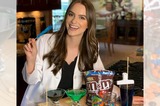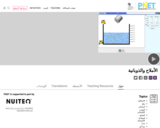
Exploring relationships among factors, zeros, and solutions - Mathematics Instructional Plan
- Subject:
- Mathematics
- Material Type:
- Lesson Plan
- Provider:
- VDOE
- Author:
- VDOE
- Date Added:
- 10/07/2024

Exploring relationships among factors, zeros, and solutions - Mathematics Instructional Plan

Learn about concentrations of solutions. If you brew tea or coffee for too long, it gets really strong, bitter, and dark. But if you add water, you can lessen its strength. So, when we talk about how strong our coffee is, we are really talking about CONCENTRATION. Like stirring a teaspoon of sugar into a cup of tea, solids can have a concentration in a liquid, but first, they need to be able to dissolve into a solution (solubility). But, is there a limit to how much of a solid the solution can take in? Through some sweet treats, you can eat, let's explore the scientific concepts of concentration, solubility, and supersaturated solutions. I promise you it's going to ROCK! Developed for students in grades 6-10.

Video Description: Learn about the global cooperation to build the International Space Station, or ISS. Use a simple scale model to demonstrate the amazing mathematical relationship between the Earth and moon and see how the low-Earth orbit of ISS compares. Video Length: 5:57.NASA eClipsTM is a suite of online student-centered, standards-based resources that support instruction by increasing STEM literacy in formal and nonformal settings. These free digital and downloadable resources inform and engage students through NASA-inspired, real-world connections.NASA eClips Our World videos (grades 3-5) help students understand the differences between science (the natural world) and engineering (the designed world). These video segments supplement elementary learning objectives not only in science, technology, engineering and mathematics, but also in reading, writing, visual and performing arts.

Video Description: Visit a lab at NASA's Johnson Space Center where scientists study meteorites. Learn how aerogel, the lightest material in the world helped capture pieces of a comet and return the comet dust to Earth. See what scientists can learn about our universe from these tiny particles. Video Length: 6:35.NASA eClips is a suite of online student-centered, standards-based resources that support instruction by increasing STEM literacy in formal and nonformal settings. These free digital and downloadable resources inform and engage students, through NASA-inspired, real-world connections.NASA eClips Our World videos (grades 3-5) help students understand the differences between science (the natural world) and engineering (the designed world). These video segments supplement elementary learning objectives not only in science, technology, engineering and mathematics, but also in reading, writing, visual and performing arts.

Add different salts to water, then watch them dissolve and achieve a dynamic equilibrium with solid precipitate. Compare the number of ions in solution for highly soluble NaCl to other slightly soluble salts. Relate the charges on ions to the number of ions in the formula of a salt. Calculate Ksp values. Arabic Language.